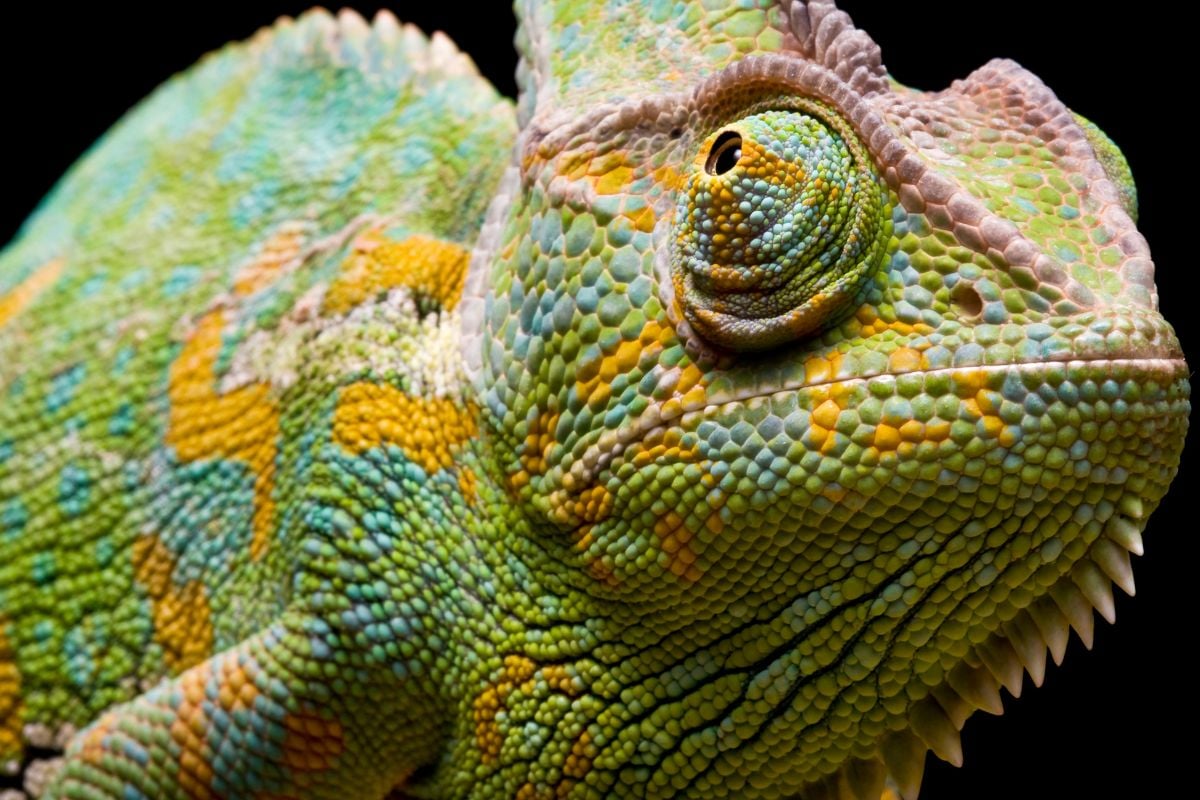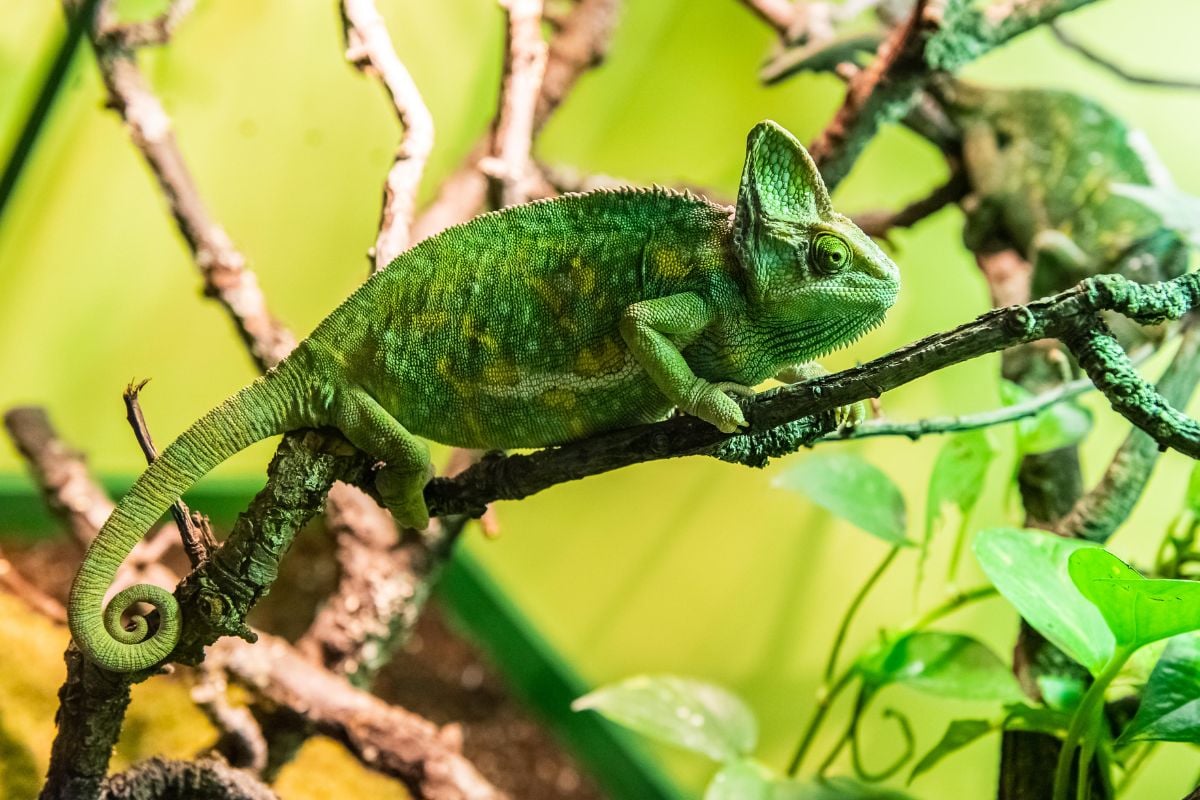The veiled chameleon is a species of reptile that originates from Saudi Arabia and Yemen.
These chameleons have a distinctive appearance thanks to the large casques that are found on their heads. These reptiles tend to be green, brown, and yellow, though they can change color based on different factors.

Veiled chameleons are hard to look after. Therefore, they are not well-suited to beginners who have limited experience in caring for reptiles.
If you want to look after a veiled chameleon, this care sheet will tell you everything that you need to know (see also “Red Headed Agama Care Sheet“). This includes their diet and housing options.
Veiled Chameleon Care Sheet
Size
The veiled chameleon is one of the longest species that can be kept in captivity. The male of the species is slightly longer than the female.
An adult male will be roughly 2 feet long, while an adult female will reach approximately 18 inches in length.
When they first hatch, a veiled chameleon will be just 3 inches long. As they age, your chameleon will gradually grow in length.
Lifespan
In captivity, veiled chameleons tend to live for between 6 and 8 years. This is only true of healthy male veiled chameleons that have received the right care (see also “Panther Chameleon Care Sheet“).
Unfortunately, female veiled chameleons have a shorter lifespan, often living for just 4 to 6 years. The main reason for this is that a female chameleon will produce eggs, which is an exhausting process.
Poorly kept veiled chameleons will have shorter lifespans.
Diet
The diet of a veiled chameleon will primarily be formed of crickets. Chameleons are insectivores, meaning that they can get all of the nutrients they need merely from insects.
There are plenty of insects that your veiled chameleon can eat, including:
- Crickets
- Hornworms
- Roaches
- Waxworms
- Mealworms
- Silkworms
- Grasshoppers
- Banana roaches
Veiled chameleons can also eat certain forms of greenery. However, this is not their favorite form of food, as they much prefer insects. Not to mention, these reptiles don’t need greenery to survive.
If you want to give your veiled chameleon a bit of variety, you should consider feeding it sweet potatoes, bell peppers, and squash.
Some fruits can also be given to this reptile, though it’s best to keep these as occasional treats. This is because fruits tend to be high in sugar.
It’s recommended that you use gut loading. This is the process of feeding nutritious foods to the prey of your animal. This means that your pet will benefit from eating these nutrients.
In this case, you should feed nutritious vegetables to the insects that you will give to your veiled chameleon.
Vitamin supplements may also be used to increase the nutritional value of your veiled chameleon’s diet. If you want to do this, you will need to dust the insects in a suitable supplement, such as calcium.
Water
In the wild, veiled chameleons would drink the water droplets from leaves following heavy dew. In captivity, reptile owners should try to mimic this situation.
The reason for this is that veiled chameleons may not recognize a water bowl as a legitimate source of water.
Therefore, you should try to place droplets of water on the leaves in your reptile enclosure so that your chameleon is encouraged to lick them.
Portioning
Younger veiled chameleons will need to be fed more regularly than adult reptiles. Namely, baby and juvenile veiled chameleons should be fed one or two times a day.
Meanwhile, adult veiled chameleons will only need to be fed every two days.
Yet, adult chameleons should be given more food than babies. Adult veiled chameleons can eat in the region of 7 and 10 large insects or 11 to 18 small insects each day.
It’s important to keep an eye on how much food your veiled chameleon is eating. If it regularly leaves food untouched, this could be an indication that you are feeding it too much.
If this is the case, simply reduce the amount of food that you are giving your pet.
Additionally, you must not keep untouched food in the cage of your chameleons for a long time.

Availability
Veiled chameleons are fairly rare. However, they are becoming increasingly common thanks to the hard work of breeders. These specially bred veiled chameleons are better able to adjust to the conditions of captivity.
If you are searching for a veiled chameleon, ensure that you purchase one from a reputable breeder who has received positive reviews.
Housing
Once they have reached roughly 8 months of age, it’s recommended that you invest in separate cages for veiled chameleons.
After this age, chameleons that are kept in the same cage will likely fight, which could lead to unnecessary injuries. Chameleons are naturally solitary creatures, so it makes sense to separate them.
You need to invest in a cage that gives your veiled chameleon plenty of space. To immerse your veiled chameleon into its enclosure, you must also include decor that mimics its natural habitat.
Be sure to add leaves, branches, and vines. Just make sure that you invest in non-toxic plants, as chameleons may take a bite out of them.
This species will also need a moderate humidity of approximately 50% during the day. During the night, you can raise the humidity. Namely, this humidity can be in the range of 75% and 100% at night. Invest in a hygrometer to check the humidity.
Veiled chameleons are cold-blooded creatures. During the day, you will have to use a heat lamp to echo natural sunlight. In the daytime, a veiled chameleon enclosure should be between 70°F and 80°F/ 21°C and 26°C.
Meanwhile, the temperatures should fall during the night. In these periods, a veiled chameleon house should be between 55°F and 65°F or 13°C and 18°C.
Final Thoughts
If you love reptiles, veiled chameleons can make great pets. As with any animal, it’s important to take the correct steps to ensure that your veiled chameleon is properly cared for.
By following this care sheet, you can guarantee that your veiled chameleon has the housing and diet that it requires to thrive (see also “Chinese Water Dragon Care Sheet“).
- Can Leopard Geckos Eat Silkworms? - March 11, 2024
- Do Leopard Geckos Climb? - March 4, 2024
- Do Leopard Geckos Bask? The Answer Will Surprise You - February 21, 2024
